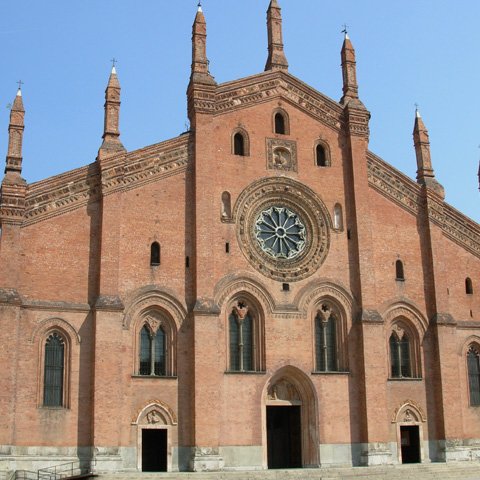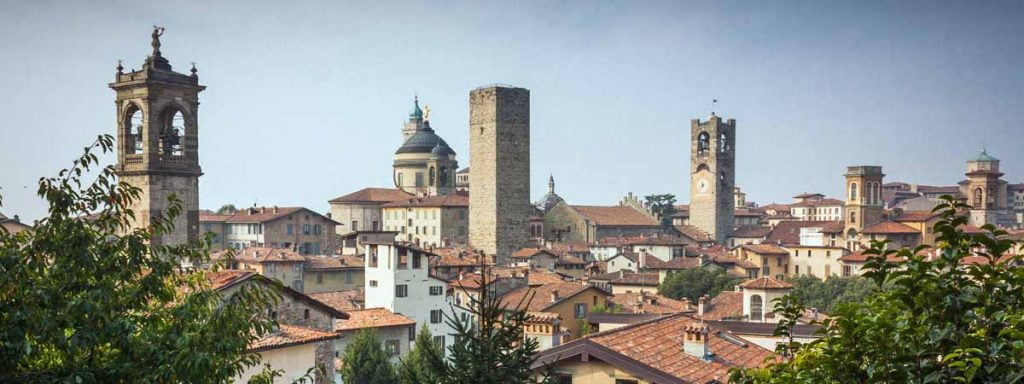Pavia is a city in Northern Italy known for being a business and university town and is located approximately 25 miles south of Milan. Nestled alongside the banks of the Ticino River, not far from where it crosses paths with the famous Po River, Pavia is home to just over 70,000 people.
The city’s fame stems from its history as the capital of the Lombard kingdom, a title which Pavia held from 572 to 774 AD. Though the days of Pavia being a central political power are over, the history of its glory days can be experienced in many ways today. Travelers can view ancient artwork, architecture, and relics of times gone by throughout the city, which features an ancient Roman-style street plan. The city center is car-free so travelers can easily explore it on foot. The city is also home to a theater, Teatro Fraschini, which was built in 1700, where travelers can view opera, ballet, and orchestral performances.
The economy in Pavia is based heavily in textiles, a booming industry for much of Northern Italy. Specifically, the city of Pavia is renowned for its hat making. Pavia also contributes to the metallurgical and engineering industries of Italy. Due to the geography of the area, which features lush lands ideal for growing produce, Pavia is also known for its wine production. It is one of Italy’s top winemaking areas and it is the biggest producer of Pinot Noir in the country. Other agricultural products Pavia produces include rice, dairy products, and grains.
The culture and atmosphere of the city are majorly influenced by its identity as a college town. Pavia is home to the University of Pavia, an ancient, historic university that was established in 1361. There are also additional educational facilities throughout the city, including other universities and academies. Despite many students commuting in from nearby Milan and surrounding areas, the universities’ students make up a large portion of Pavia’s population, giving the city a youthfulness and vitality, which compliments its rich, vast history.
Pavia was first founded by the Romans but made its biggest impact when it became the capital of the Kingdom of the Lombards in 572. In 774, Charlemagne crowned himself the King of Italy in Pavia, ending the rule of the Lombards in the area. Throughout the next few centuries, multiple kings would be crowned in Pavia, including Berengar and Emperor Frederick I Barbarossa. The city was a major rival of Milan for many years until it surrendered to Milan in 1359. Throughout this history, Pavia’s most notable structures were built, earning Pavia the title of the “City of a Hundred Towers.” Today, approximately 60 of these towers remain in some form, with approximately six still fully intact.
GEOGRAPHY & CLIMATE
The city of Pavia is located in Northwestern Italy in the province of the same name. The provinces that surround Pavia are Milan and Lodi to the north, Piacenza to the southeast, and Alessandria to the southwest.
Pavia’s climate is temperate and warm, with a good amount of precipitation throughout the year. Travelers can expect some humidity or rain, even in drier months.
Approximately two and a half miles south of the city of Pavia is the confluence of the Ticino and Po Rivers. Much of the province of Pavia is flat. The combination of plains, a moderately warm climate with sufficient precipitation, and land that is enriched by the two rivers makes the province an excellent location for agriculture.
WHEN IN PAVIA
Visit the Certosa, a Carthusian Monastery located approximately five miles north of the city center. One of Pavia’s biggest draws, the Certosa is a monastery and complex that was built in 1396. It is known for being one of Italy’s largest and most important monasteries, as well as for its tremendous Gothic and Renaissance style architecture. It also holds a vast collection of artwork and houses tombs that serve as the final resting place for a variety of important figures of history, such as former Dukes and Duchesses of Milan, including Ludovico Sforza, Beatrice d’Este, and Gian Galeazzo Visconti.
Visit the Romanesque Basilica of San Pietro in Ciel D’Oro. Italian for “Saint Peter in the Golden Sky,” this basilica is the home of the tomb of St. Augustine, the most renowned convert of Christianity. Throughout the basilica are stunning architectural elements such as gold-leaf mosaics, sandstone quoins, and more.
See Castello Visconteo, a fourteenth-century fortress. This castle is home to the Museo Civico (Municipal Museum), which contains a sculpture gallery filled with Romanesque and Renaissance sculptures, a collection of archaeological relics, and a photo gallery with works by artists such as Correggio, Bellini, and more.
Spend time at the historic University of Pavia. The medieval center is dominated by the University, which was founded as school in the nineteenth century and officially became a university in 1361. Christopher Columbus was a student here, while Alessandro Volta, inventor of the battery, was a lecturer at the university.
Enjoy unique Pavese cuisine such as Pavese soup (a delicious soup made of broth, eggs, and cheese), one of a kind duck and goose salame, and stand-out DOC wines such as Pinot Noir, Moscato, and Pinot Grigio.
Go sightseeing to view any one of Pavia’s many Renaissance churches. Some of the top churches include the Cathedral of Pavia, San Michele Maggiore, San Francesco d’Assisi, San Teodoro, and more. These religious sites are filled with history and are representative of the area’s unique architectural styles.
The charming city of Pavia is typically associated with its most renowned site, the Certosa of Pavia. In addition to this famous monastery complex, travelers to Pavia should be sure to take in the stunning medieval towers and enjoy the rich cuisine of the area.
Travel Guides
The Lombardy Region of Italy
The Cities of Lombardy, Italy





